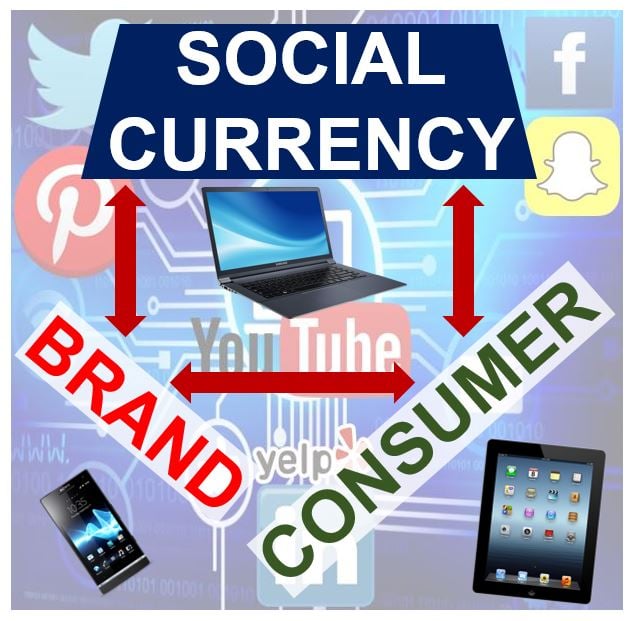Social Currency is a popular term that has not been around for long. It is understood as all the existing and potential resources that arise from the presence of social networks and communities – either online or offline.
Put simply, social currency is information that is shared by people as they go about their everyday lives.
It is the total economic value of each person’s or entity’s relationships, both in real life and on the Internet.
Just like gravity and magnetism, we can feel its effects but cannot really point at it and pick out any individual item as social currency.
Six types of behavior
Six types of behavior lead to social currency: Conversation, Information, Advocacy, Identity, Affiliation, and Utility.
Much of a brand’s social currency today is achieved online. Any company that ignores how consumers and customers interact and behave on the Internet are likely to fail in the current, highly competitive marketplace.

It derives from the social capital theory put forward by Pierre Bourdieu, (1930-2002), a French sociologist, anthropologist, philosopher and well-respected public intellectual. It is about increasing our sense of community, granting access to knowledge and information, and helping create our own identities, as well as providing status and recognition.
The best definition of Social Currency in the fewest words possible that I have seen, was written by Russ Klein in an American Marketing Association blog:
“Social currency refers to the pull or influence that a consumer has among his peers, and social currency strategies are arguably the most critical point of leverage for a marketer.”
Social currency in business
Marketing professionals say that social currency is the extent to which we share information regarding a brand as part of our everyday social lives at home or at work.
This sharing helps commercial enterprises create unique brand identities and gain permission to interact with customers or consumers. Social currency has become a major focus for companies in order to create value for themselves.
Brands are built through experiences, through individuals accepting them and making them part of the fabric of their everyday lives. The process of building strong brands is extremely personal as well as very social.
According to Erich Joachimsthaler, Founder and CEO of Vivaldi Partners Group, a growth strategy firm: “There is this massive amount of information that consumers are willing to share today. They engage in conversations with brands or people, they advocate for brands or people, they communicate, they become part of communities. Managers need to understand how consumers engage with their brands in the digital and social universe.”
A brand’s strength is its social currency
One of the major strengths of a brand in the world today is its social currency – the extent to which consumers share the brand or information about it with others as an integral part of their everyday social lives.
The dramatically rapid evolution of the Internet – plus the explosion of the social web’s forms of media, technologies and networks – have changed how we live and how brands are built.
According to Dr. Erich Joachimsthaler, Founder and CEO of Vivaldi Partners:
“We find that social currency is not just about conversation, buzz, or community. It is all this and much more. We find that it does not impact every brand equally. We find that certain levers of social currency are more important than others in driving value for companies.”
Why do brands need social currency?
Brands represent considerable assets for businesses. A brand’s strength is closely linked to a number of well-known asset dimensions that drive relationships with consumers.
The nature of the Internet, smartphones and other mobile technologies has become extremely social for consumers – they integrate the new technologies and platforms into their everyday lives and contexts. A good brand manager needs to understand how they interact in all parts of life with brands, products, people and businesses.
Hence, every business today must learn how to make its brand more social, and how to interact in novel ways with its customers. Put simply, it needs to develop social currency.
John Berger, a British art critic, poet, painter and novelist, who was awarded the Booker Prize in 1972, once said: “So to get people talking, companies and organizations need to mint social currency. Give people a way to make themselves look good while promoting their products and ideas along the way. There are three ways to do that: 1. find inner remarkability; 2. leverage game mechanics; and 3. make people feel like insiders.”
Social currency – an experiential concept
The social currency of a brand evolves organically in the network of human beings – customers, consumers, suppliers and partners. (Customer usually equals consumer, in most cases, but not all. For example: if I buy food for my baby daughter, I am the customer but she is the consumer, because she is the end user.)
Social currency is an experiential concept and not a communications approach. It develops from consumers’ experiences, specifically those in their everyday lives.
-
A delicate asset to build
According to the Vivaldi Group:
“Understanding social currency requires to understand how the context of daily life changes and increasingly covers the range of experiences on how consumers interact with brands, products and companies from traditional to digital experiences.”
“Social Currency is neither a product feature, nor a communications or PR campaign that is completely managed by any one company. From this perspective, social currency is a far more delicate asset to build, nurture and maintain than brand equity.”
“Traditional brand management has been a successful driver for many brands. Many of the Top 1000 global brands have grown over the last twenty years. All these brands derive strength from deep relationships and interactions with customers or consumers, and by that, social currency is not a new phenomenon. Brand building has always been about establishing deep relationships with customers or consumers and share their experiences with friends and peers – their everyday social environment.”
-
A key source of strength for brands
The explosion of online social platforms over the past decade means that social currency has become a key source of strength for most brands across the world.

Just as major online networking websites like Twitter, Facebook Instagram, LinkedIn and Instagram have become important means through which human beings exchange everyday information, brands have also grown in those media.
A growing number of companies are now using these social media websites to strengthen customer service, introduce new products and services, and keep people entertained.
Social currency can also be enhanced through thousands of small forums, blogs and networks that the brands themselves do not steer.
In today’s marketplace, building social currency takes several forms, some operating online and others in the non-digital world, but all related to consumers’ daily lives.
Social currency and F-commerce
F-commerce (Facebook commerce) is a strategy that concentrates on developing and designing e-commerce content and storefront sites within social networking sites like Facebook. The rise of F-commerce has been spectacular.
The value of social media to marketing executives is still being defined, but all commercial enterprises across the globe have a social currency they are able to exploit.
-
Social media – a new value proposition
The sharing of opinions, experiences, purchases and information is a currency that every company possesses. Social media represents a new value proposition to brand owners that may potentially deliver colossal dividends to those marketers who are able to appreciate its value and develop its extensive potential.
According to IDC data examined by the Incite Group, more than three-quarters of all the information online is generated by individuals. Consumers today have literally become the custodians of much of the value that brands enjoy today.
In order to leverage the available social currency, one must engage in conversations with these brand advocates.
As we move into an era where virtual and augmented realities become commonplace, the dynamics of social currency are expected to evolve further, making it imperative for brands to explore innovative ways to harness its potential in these emerging digital landscapes.
Social currency vocabulary and concepts
There are many compound phrases containing the words “social currency” in the English language. Let’s have a look at some of them:
-
Social Currency Acquisition
The process of obtaining value through social interactions and networking.
Example: “The influencer focused on social currency acquisition to increase her brand partnerships.”
- Social Currency Metrics
Quantitative measures used to assess the value of social interactions and influence.
Example: “Companies use social currency metrics to gauge the impact of their marketing campaigns.”
-
Social Currency Management
The strategic planning and control of resources that build social influence and relationships. Example: “Effective social currency management has become essential for customer relationship strategies.”
-
Social Currency Investment
Allocating time and resources to activities that enhance one’s influence and relationships within a social network.
Example: “He considered his time volunteering as social currency investment towards his community standing.”
-
Social Currency Exchange
The process by which social value is traded, often for mutual benefit in reputation or influence. Example: “The social currency exchange between the mentor and the protégé was beneficial for both parties.”
-
Social Currency Portfolio
A diversified collection of social assets, such as relationships and reputation, that can be leveraged for personal or business gain.
Example: “She built a diverse social currency portfolio through her involvement in various non-profit organizations.”
Educational Video – What is Social Currency?
This interesting video, from our YouTube partner channel – Marketing Business Network, explains what ‘Social Currency’ means using simple and easy-to-understand language and examples.
